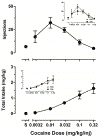Effects of chronic cocaine self-administration and N-acetylcysteine on learning, cognitive flexibility, and reinstatement in nonhuman primates
- PMID: 30877326
- PMCID: PMC6626691
- DOI: 10.1007/s00213-019-05211-5
Effects of chronic cocaine self-administration and N-acetylcysteine on learning, cognitive flexibility, and reinstatement in nonhuman primates
Abstract
Rationale: Cocaine use disorder (CUD) is associated with cognitive deficits that have been linked to poor treatment outcomes. An improved understanding of cocaine's deleterious effects on cognition may help optimize pharmacotherapies. Emerging evidence implicates abnormalities in glutamate neurotransmission in CUD and drugs that normalize glutamatergic homeostasis (e.g., N-acetylcysteine [NAC]) may attenuate CUD-related relapse behavior.
Objectives: The present studies examined the impact of chronic cocaine exposure on touchscreen-based models of learning (repeated acquisition) and cognitive flexibility (discrimination reversal) and, also, the ability of NAC to modulate cocaine self-administration and its capacity to reinstate drug-seeking behavior.
Methods: First, stable repeated acquisition and discrimination reversal performance was established. Next, high levels of cocaine-taking behavior (2.13-3.03 mg/kg/session) were maintained for 150 sessions during which repeated acquisition and discrimination reversal performance was probed periodically. Finally, the effects of NAC treatment were examined on cocaine self-administration and, subsequently, extinction and reinstatement.
Results: Cocaine self-administration significantly impaired performance under both cognitive tasks; however, discrimination reversal was disrupted considerably more than acquisition. Performance eventually approximated baseline levels during chronic exposure. NAC treatment did not perturb ongoing self-administration behavior but was associated with significantly quicker extinction of drug-lever responding. Cocaine-primed reinstatement did not significantly differ between groups.
Conclusions: The disruptive effects of cocaine on learning and cognitive flexibility are profound but performance recovered during chronic exposure. Although the effects of NAC on models of drug-taking and drug-seeking behavior in monkeys are less robust than reported in rodents, they nevertheless suggest a role for glutamatergic modulators in CUD treatment programs.
Keywords: Cocaine; Cognitive flexibility; Learning; N-acetylcysteine; Nonhuman Primates; Reinstatement; Self-administration.
Conflict of interest statement
Conflict of Interest
The authors have no conflicts of interest to report.
Figures






Similar articles
-
Glutamate transporter GLT-1 mediates N-acetylcysteine inhibition of cocaine reinstatement.Addict Biol. 2015 Mar;20(2):316-23. doi: 10.1111/adb.12127. Epub 2014 Feb 25. Addict Biol. 2015. PMID: 24612076 Free PMC article.
-
N-acetylcysteine amide (AD4) reduces cocaine-induced reinstatement.Psychopharmacology (Berl). 2016 Sep;233(18):3437-48. doi: 10.1007/s00213-016-4388-5. Epub 2016 Jul 28. Psychopharmacology (Berl). 2016. PMID: 27469021
-
The effects of N-acetylcysteine on cocaine reward and seeking behaviors in a rat model of depression.Behav Brain Res. 2014 Jun 1;266:108-18. doi: 10.1016/j.bbr.2014.02.044. Epub 2014 Mar 5. Behav Brain Res. 2014. PMID: 24613240
-
D-amphetamine maintenance therapy reduces cocaine use in female rats.Psychopharmacology (Berl). 2022 Dec;239(12):3755-3770. doi: 10.1007/s00213-022-06271-w. Epub 2022 Nov 11. Psychopharmacology (Berl). 2022. PMID: 36357743 Review.
-
PET studies in nonhuman primate models of cocaine abuse: translational research related to vulnerability and neuroadaptations.Neuropharmacology. 2014 Sep;84:138-51. doi: 10.1016/j.neuropharm.2013.02.004. Epub 2013 Feb 28. Neuropharmacology. 2014. PMID: 23458573 Free PMC article. Review.
Cited by
-
N-acetylcysteine in substance use disorder: a lesson from preclinical and clinical research.Pharmacol Rep. 2021 Oct;73(5):1205-1219. doi: 10.1007/s43440-021-00283-7. Epub 2021 Jun 6. Pharmacol Rep. 2021. PMID: 34091880 Free PMC article. Review.
-
Cognitive performance as a behavioral phenotype associated with cocaine self-administration in female and male socially housed monkeys.Neuropsychopharmacology. 2024 Oct;49(11):1729-1737. doi: 10.1038/s41386-024-01882-7. Epub 2024 May 17. Neuropsychopharmacology. 2024. PMID: 38760425 Free PMC article.
-
Effects of long-term cocaine self-administration on brain resting-state functional connectivity in nonhuman primates.Transl Psychiatry. 2020 Dec 2;10(1):420. doi: 10.1038/s41398-020-01101-z. Transl Psychiatry. 2020. PMID: 33268770 Free PMC article.
-
Discrimination learning in oxycodone-treated nonhuman primates.Drug Alcohol Depend. 2020 Feb 1;207:107778. doi: 10.1016/j.drugalcdep.2019.107778. Epub 2019 Nov 27. Drug Alcohol Depend. 2020. PMID: 31816487 Free PMC article.
References
-
- Aharonovich E, Hasin DS, Brooks AC, Liu X, Bisaga A, Nunes EV (2006) Cognitive deficits predict low treatment retention in cocaine dependent patients. Drug Alcohol Depend 81:313–322. - PubMed
-
- Baker DA, McFarland K, Lake RW, Shen H, Tang XC, Toda S, Kalivas PW (2003) Neuroadaptations in cystine-glutamate exchange underlie cocaine relapse. Nat Neurosci 6:743–749. - PubMed
MeSH terms
Substances
Supplementary concepts
Grants and funding
LinkOut - more resources
Full Text Sources

